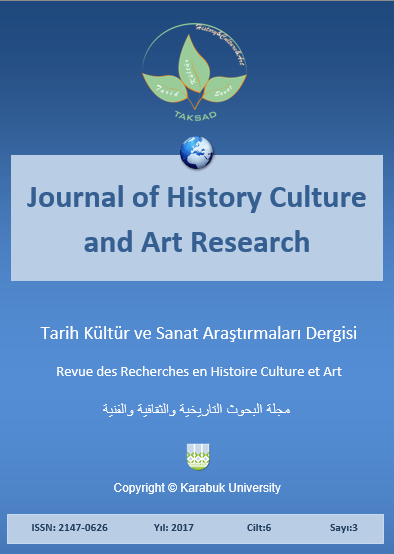A Theoretical Framework for the Evaluation from the Traditional Mashrabiya to Modern Mashrabiya
DOI:
https://doi.org/10.7596/taksad.v6i3.962Anahtar Kelimeler:
Mashrabiya- Arab identity- Functions- Re-thinking- Traditional architecture.Özet
Finding a favorable trade-off between saving the architectural heritage, and assuring the development of modern architecture is a delicate and precise task, due to the lack of knowledge in the original criteria for the re-thinking of traditional architecture. As a tentative answer to this challenge, this paper attempts to shed light on Mashrabiya (traditional Arab oriel window) as a powerful environmental element in modern architecture, with regard to the important functions that it provides, such as light control, airflow regulation, humidity control, temperature regulation and visual privacy. Due to these functions, Mashrabiya achieved widespread popularity around the old world and it has been revived again in many contemporary projects by different modern versions. The objective of this study also is presenting a general evaluation for the modern Mashrabiya to observe the misconceptions of using the Mashrabiya and to call for stop ignoring of the proper standards of Mashrabiya design and to preserve the original name of this element "Mashrabiya".
Referanslar
Abdelsalam T. & Rihan, G. (2012). The impact of sustainability trends on housing design identity of Arab cities. Housing and Building National Research Centre of HBRC Journal, 9(2), 159-172.
Aedas (2012). The Architectural design team of AlBahar Tower. Retrieved from: http://www.archdaily.com/270592/al-bahar-towers-responsive-facade-aedas
Akbar, S. (1994). The diminishing role of windows from traditional to modern. In Proceeding of the International Conference on the Role of Windows in Saudi Arabia (pp. 16-21). Jeddah, Saudi Arabia.
Alothman, H. (2017). An Evaluative and Critical Study of Mashrabiya in Contemporary Architecture (pp. 93-162). Master Thesis, Near East University, Nicosia, North Cyprus.
Amit, G. (2011). The photographer Mashrabiya House in Palestine. Retrieved from: http://www.archdaily.com/175582/the-mashrabiya-house-senan-abdelqader/50160dac28ba0d1598000902-the-mashrabiya-house-senan-abdelqader-photo
Ashi, A. (2010). Theories and History of Architecture. Homs, Syria: Al Baath University Press.
Ashraf, S. (1983). Elrawashin of Jeddah, Saudi Arabia: Passive and low energy. The International Journal of Architectural Research, 1(1), 9-12.
Briggs, S. (1974). Architecture in Egypt and Palestine (pp. 213-214). New York, NY: Da Capo Press.
Caine, T. (2014). Photographer of Masdar City. Retrieved from: http://www.archdaily.com/517456/inside-masdar-city/539b46d9c07a805cea000834-inside-masdar-city-photo
Dayyob, T. (2001). History of Arab Architecture. Homs, Syria: AlBaath University Press.
Fathy, H. (1986). Natural Energies and Vernacular Architecture, Mashrabiya (pp. 46-49). Chicago, USA: The University of Chicago Press.
Feeney, J. (1974). The Magic of Mashrabiya. Journal of AL Riyadh, 25(4) 32-36.
Ficarelli, L. (2008). The Domestic Architecture in Egypt between Past and Present. The Passive Cooling in Traditional Construction. In Proceedings of the Third
International Conference on Construction History, (Vol.2, pp. 54-72). Cottbus, Germany: University of Technology.
Gelil, N. & Ali, W. (2014). Traditional Residential Architecture in Cairo from a Green Architecture Perspective. In Proceeding of the International Conference of Art and Design Studies (Vol. 14, pp. 6- 23). Egypt- 6th of October City: October University for Modern Sciences and Arts ,MSA University.
Marawan, R. (2016). An old Mashrabiya at Al Suhaymi House in Cairo, Egypt. Retrieved from: http://www.imgrum.org/media/1203558523401670886_340619099
Maspero, G. (1974). Manual of Egyptian Archaeology and Guide to the Study of Antiquities in Egypt. New York, NY: Putnams Sons Press.
Mecanoo Architects (2013). Architects of Library of Birmingham. Retrieved August 29, 2013 from: http://www.archdaily.com/421970/library-of-birmingham-mecanoo
Richters, Ch. (2012). Photographer of Mashrabiya facade at Al Bahr Towers. Retrieved from: http://www.archello.com/en/project/abu-dhabi-investment-council-new-headqurters-al-bahr-towers
Richters, Ch. (2013). Photographer of Library of Birmingham in the United Kingdom. Retrieved March 9, 2015 from http://www.archdaily.com/421970/library-of-birmingham-mecanoo/521f4b14e8e44e56b5000003-library-of-birmingham-mecanoo-photo
Samuels, W. (2011). Performance and Permeability: An Investigation of the Mashrabiya for Use within the Gibson Desert in Australia (pp. 42-57). Master Thesis, School of Architecture and Design of Victoria University, Wellington, New Zealand.
İndir
Yayınlanmış
Nasıl Atıf Yapılır
Sayı
Bölüm
Lisans
Tarih Kültür ve Sanat Araştırmaları Dergisi'nde yayımlanan tüm çalışmalar Creative Commons 4.0 CC-BY lisansı ile lisanslanmıştır.
Bunları yapmakta özgürsünüz:
- Bu eseri her boyut ve formatta paylaşabilir — kopyalayabilir ve çoğaltabilirsiniz.
- Materyalden Adapte et — karıştır, aktar ve eserin üzerine inşa et
- her türlü amaç için, ticari amaç da dahil
Alttaki şartlar altında:
Atıf — uygun bilgiyi, lisansa linki, and ve değişiklik yapıldıysa değişiklik bilgisinivermelisiniz. Sizi veya kullanımınızı lisansörün onayladığı bilgisini içermemek kaydıyla, size uygun şekilde bu işlemleri gerçekleştirebilirsiniz.
AynıLisanslaPaylaş — Eğer materyali karıştırdınızsa, aktardınızsa ya da materyalin üzerine çalıştınızsa, ancak aynı lisans ile dağıtabilirsiniz.
- Ek sınırlamalar yoktur — Lisansın izin verdiği hakları başkaları üzerinde kanunlarla ya da teknolojiyikullanarak sınırlayamazsınız.







